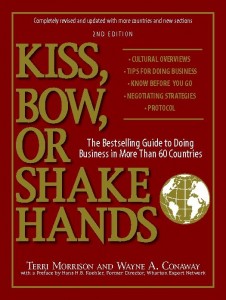Communication Abroad: Three Resources for Cultural Sensitivity
I’m getting ready to go to Japan and China to run some classes, and since I haven’t been there in a couple of years, I’ve gone back to some trusty resources to help me ensure that I can speak the language of my listeners. No, I’m not referring to actually learning Japanese and Chinese, but I do want to make sure that I am sensitive to the thinking and communication styles of my hosts and students.
As the world becomes increasingly global, it becomes more and more important for communicators to be aware that there is no one best way of thinking and communicating, and unless you get at least a passing familiarity with other cultures, you are at best leaving effectiveness on the table and at worst at risk of committing a serious faux pas.[1]
When I first went to China about fifteen years ago, I had the good fortune to read a book called Kiss, Bow, or Shake Hands . It was good fortune because it provided practical advice that definitely helped me. I was at a dinner with all my hosts, when one of them said, “Mr. Malcolm, I would like to drink a toast to you,” with a shot glass of mao tai. Fortunately, the book had prepped me for this, and I replied, “I would be honored if everyone would join in.” If I had not done that, each one in turn would have proposed a toast, and I would have ended up with about 12 shots, while of my hosts only had one. As it was, they stopped toasting after about the third shot. Who says you can’t learn anything practical from books? This one covers 60 different countries, so it’s a useful resource if you travel a lot.
While that book is still an excellent resource for customs and behaviors, another resource I’ve found to be very useful is Professor Geert Hofstede’s cultural dimensions website. Based on research he did for IBM during the 1970s, Hofstede isolated five cultural characteristics and measured the degree to which they apply to various countries (the definitions are my own, and are vastly simplified).
- Power distance: the amount of respect and acceptance that lower ranking people give to those of higher rank.
- Individualism: the amount of emphasis on group harmony vs. individual needs.
- Masculinity: emphasis on competition and achievement, vs. the feminine values of modesty and caring.
- Uncertainty avoidance: the amount of tolerance for ambiguity and unstructured situations.
- Long-term orientation: this dimension was added later, and describes the extent to which the members are willing to defer rewards.
It’s tough to go into too much detail in a short article, but I have found it helpful to, first, check out the US measurement for each characteristic, and then compare it to that of the country to which I am traveling. From Hofstede’s web site, here are the measurements for the three:
| USA | JAPAN | CHINA | |
| PDI |
40 |
54 |
80 |
| IND |
91 |
46 |
20 |
| MAS |
62 |
95 |
66 |
| UAI |
46 |
92 |
30 |
| LTO |
29 |
80 |
118 |
The web site also has a written explanation for each country that you might find helpful.
Understanding others often begins with understanding yourself, so a third resource that I’ve used and liked is Americans at Work: A Cultural Guide to the Can-Do People, by Craig Storti. It’s written to help those from other cultures understand us, and it makes for fascinating and sometimes uncomfortable reading. For example, did you know that many cultures consider that American managers don’t have good people skills? They consider us too direct, impatient and driven to truly understand the nuances of relationships and conversations. Our tendency to take things too literally leads to misunderstandings, as in this example:
BILL: We need to schedule the next team meeting.
HIROKO: Good idea.
BILL: How about next Tuesday morning?
HIROKO: Tuesday?
BILL: Yes, would 10:30 be OK?
HIROKO: 10:30? Is it good for you?
BILL: Yes, it’s fine.
HIROKO: I see.
After this exchange, Bill confidently enters the meeting date into the calendar, but Hiroko thinks he has made it quite clear that the meeting time is not good for him. He never directly answered Bill’s question, and never said yes.
Although these resources make for fascinating and useful reading, it’s important to keep in mind that they all address averages, not individuals. You can always find impatient Chinese, subservient Americans, and spontaneous Japanese, so don’t try to force-fit everyone you meet into a number.
Secondly, I haven’t seen research along these lines, but in my own travels I’ve noticed that frequently corporate culture exercises greater influence on how people think and communicate than national culture. I saw a dramatic demonstration of this in Japan two years ago, when I worked with two different companies in the same week. In the first, my audience consisted of salespeople, and they fit the Japanese image very closely. Later that week, I trained some engineers who were as open and challenging in the classroom as any American group I’ve worked with, shattering two stereotypes in the process.



